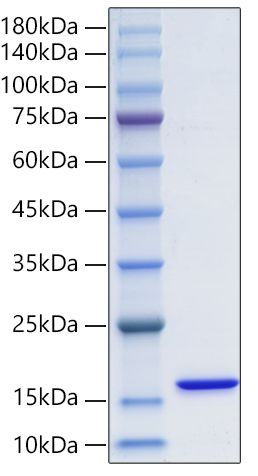Description
Recombinant Human FABP3/H-FABP Protein
The Recombinant Human FABP3/H-FABP Protein is a biologically active recombinant protein that plays a significant role in various cellular processes and signaling pathways in human biology. This protein is widely employed in immunological research, cell biology studies, protein-protein interaction analyses, and therapeutic development, providing researchers with a reliable tool for investigating FABP3/H-FABP function and its implications in health and disease.
This product (SKU: RPCB0642) is produced using E. coli and features a N-His tag for convenient detection and purification. The protein exhibits a calculated molecular weight of 15.57 kDa with an observed molecular weight of 15-20 kDa under denaturing conditions, achieving ≥ 95 % as determined by SDS-PAGE., ensuring exceptional quality and consistency for research applications.
Key Features
| High Purity by Affinity Chromatography | |
| Mammalian & Bacterial Expression Systems | |
| High lot-to-lot consistency via strict QC |
| Product Name: | Recombinant Human FABP3/H-FABP Protein |
| SKU: | RPCB0642 |
| Size: | 10 μg , 20 μg , 100 μg , 50 μg |
| Reactivity: | Human |
| Synonyms: | FABP3, FABP11, MDGI, Fatty acid-binding protein, heart, Fatty acid-binding protein 3, Heart-type fatty acid-binding protein, H-FABP, Mammary-derived growth inhibitor, MDGI, Muscle fatty acid-binding protein, M-FABP |
| Tag: | N-His |
| Expression Host: | E. coli |
| Calculated MW: | 15.57 kDa |
| Observed MW: | 15-20 kDa |
| Gene ID: | 2170 |
| Protein Description: | High quality, high purity and low endotoxin recombinant Recombinant Human FABP3/H-FABP Protein (RPCB0642), tested reactivity in HEK293 cells and has been validated in SDS-PAGE.100% guaranteed. |
| Endotoxin: | < 0.01 EU/μg of the protein by LAL method |
| Purity: | ≥ 95 % as determined by SDS-PAGE. |
| Formulation: | Lyophilized from 0.22 μm filtered solution in PBS (pH 7.4). Normally 8% trehalose is added as protectant before lyophilization. |
| Reconstitution: | Centrifuge the vial before opening. Reconstitute to a concentration of 0.1-0.5 mg/mL in sterile distilled water. Avoid vortex or vigorously pipetting the protein. For long term storage, it is recommended to add a carrier protein or stablizer (e.g. 0.1% BSA, 5% HSA, 10% FBS or 5% Trehalose), and aliquot the reconstituted protein solution to minimize free-thaw cycles. |
| Storage: | Store at -20℃.Store the lyophilized protein at -20℃ to -80 ℃ up to 1 year from the date of receipt. After reconstitution, the protein solution is stable at -20℃ for 3 months, at 2-8℃ for up to 1 week. |
FABP3/H-FABP,FABPs are thought to play a role in the intracellular transport of long-chain fatty acids and their acyl-CoA esters.Fatty acid binding protein-3 is a member of a large superfamily of lipid binding proteins that are expressed in a tissue specific manner. Although all are highly conserved in their tertiary structure, there is only modest aa identity between any two members. The FABP family members are subdivided based on organ or tissue type it was originally expressed or identified; liver- (L-FABP), intestine- (I-FABP), heart- (H-FABP), adipocyte- (A-FABP), epidermal- (E-FABP), ileal- (IL-FABP), brain- (B-FABP), myelin- (M-FABP) and testis-FABP (T-FABP). Human H-FABP, the product of the FABP3 gene, is a 132 aa cytosolic protein that shows a flattened beta -barrel structure generated by a series of antiparallel beta ‑strands and two alpha ‑helices. One molecule of FABP3 is capable of binding one long-chain fatty acid. It is suggested that ligands first bind to the outside of the molecule, and this binding subsequently induces a conformational change in the binding protein, resulting in "internalization" of the ligand. Human FABP3 is 86%, 89% and 89% aa identical to mouse, rat and canine FABP3, respectively.







